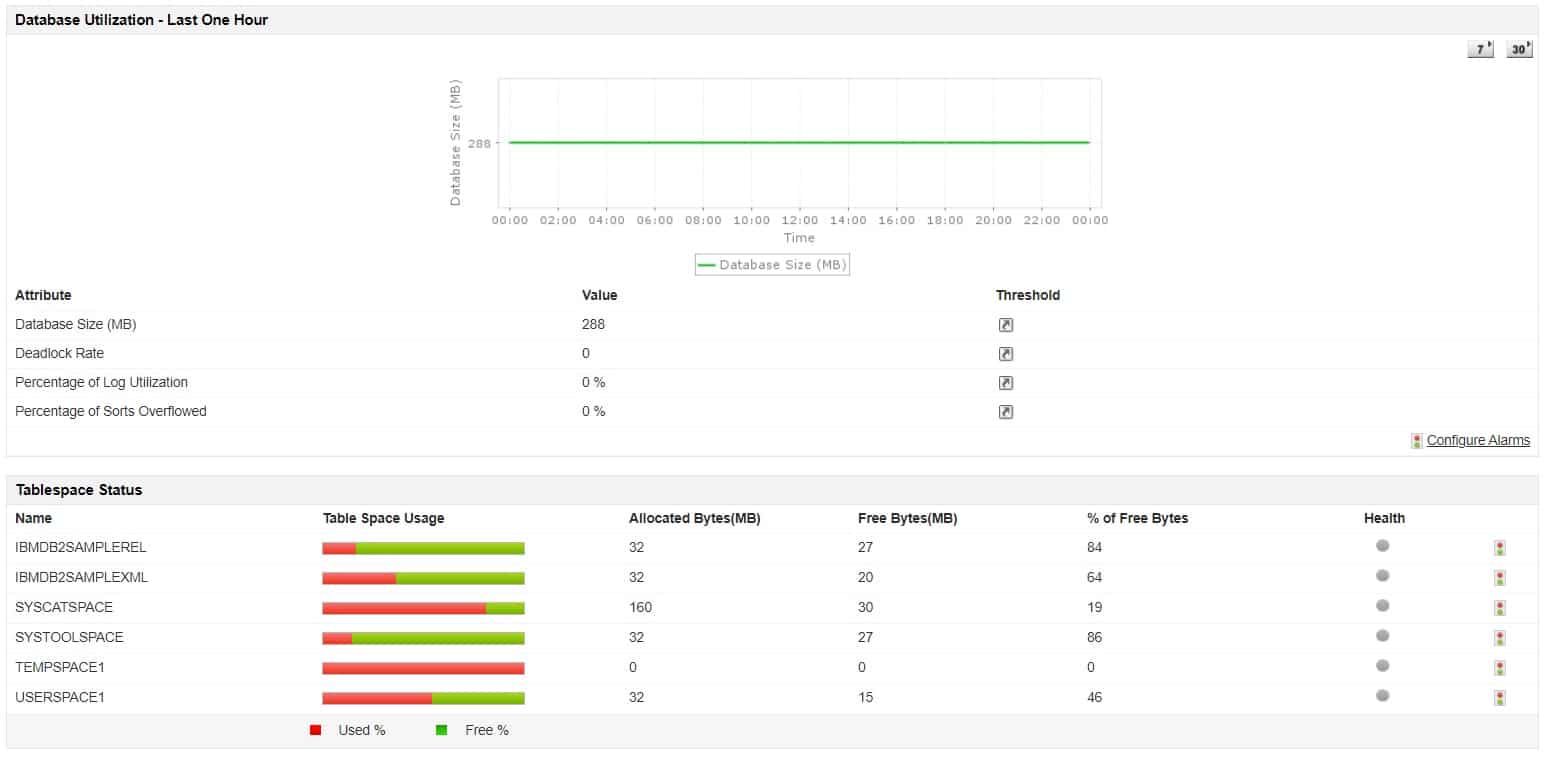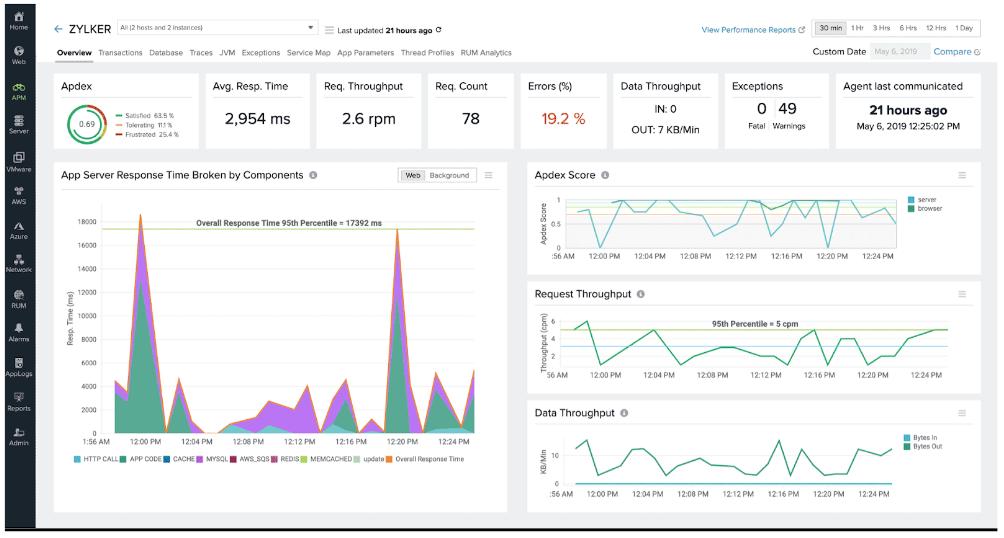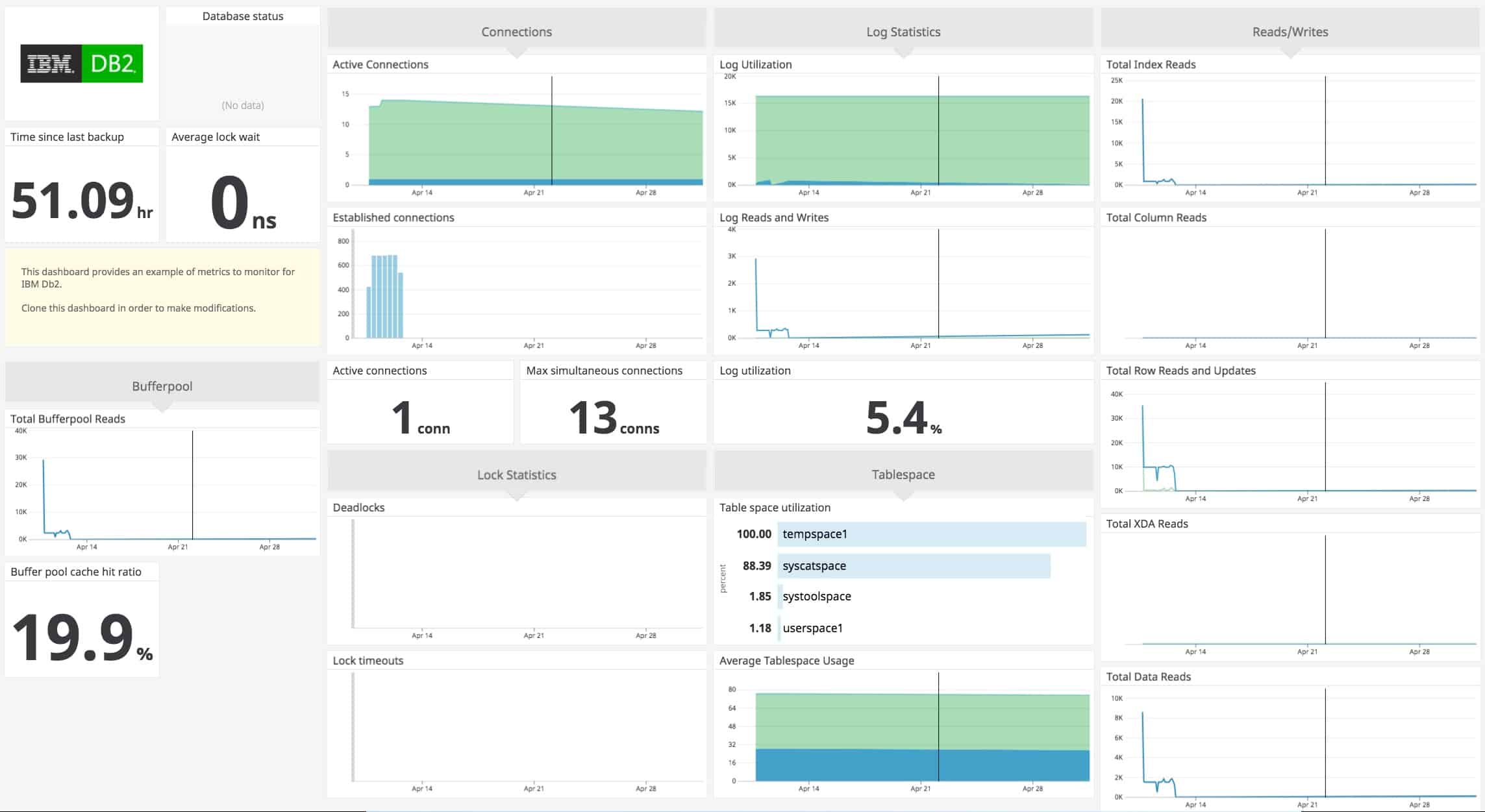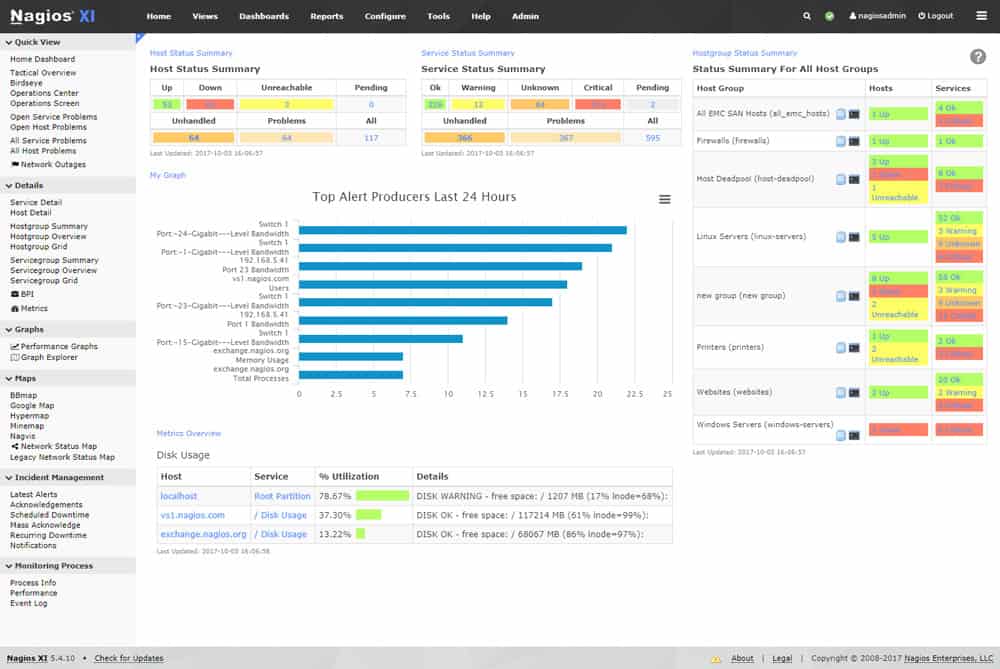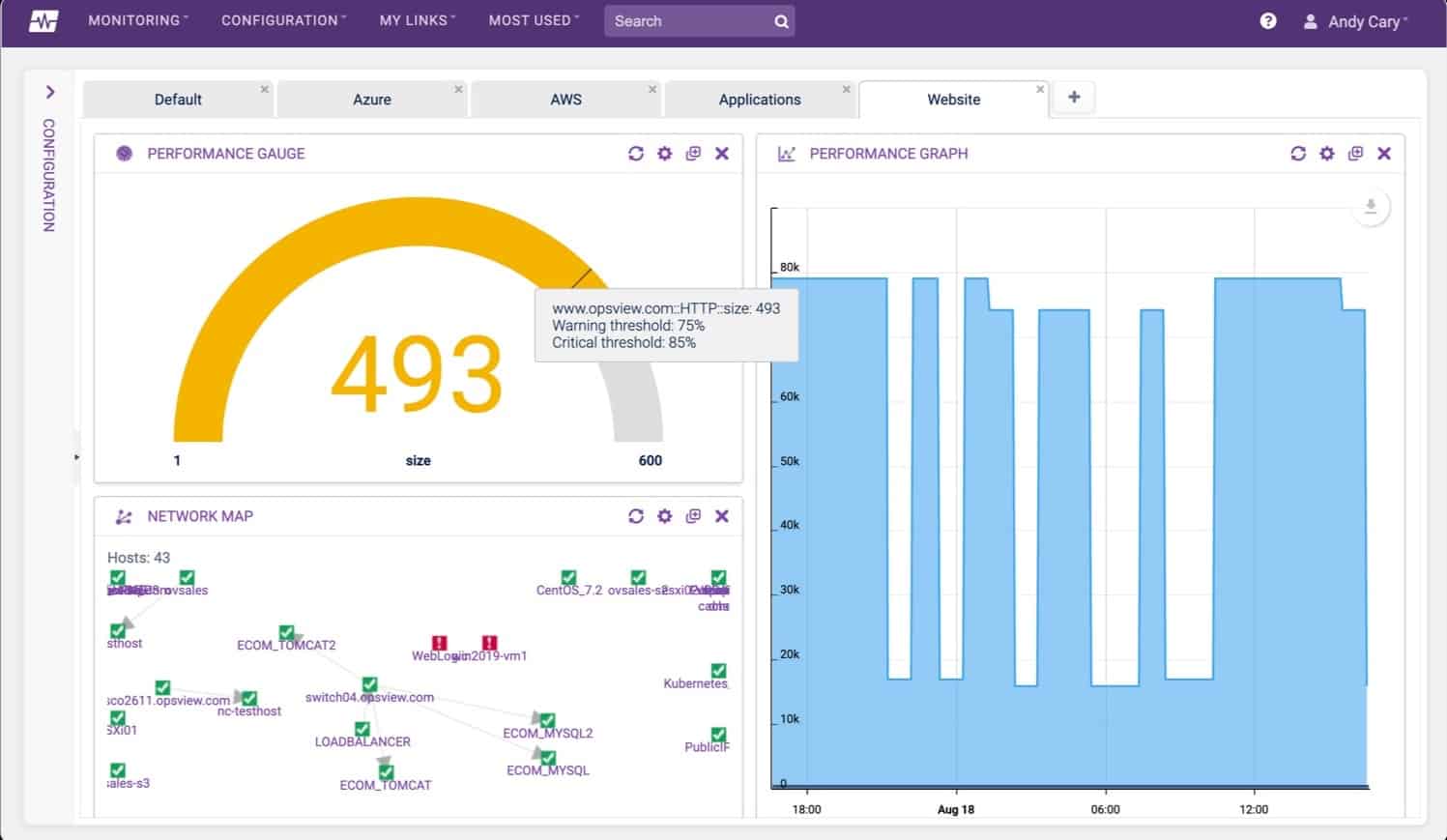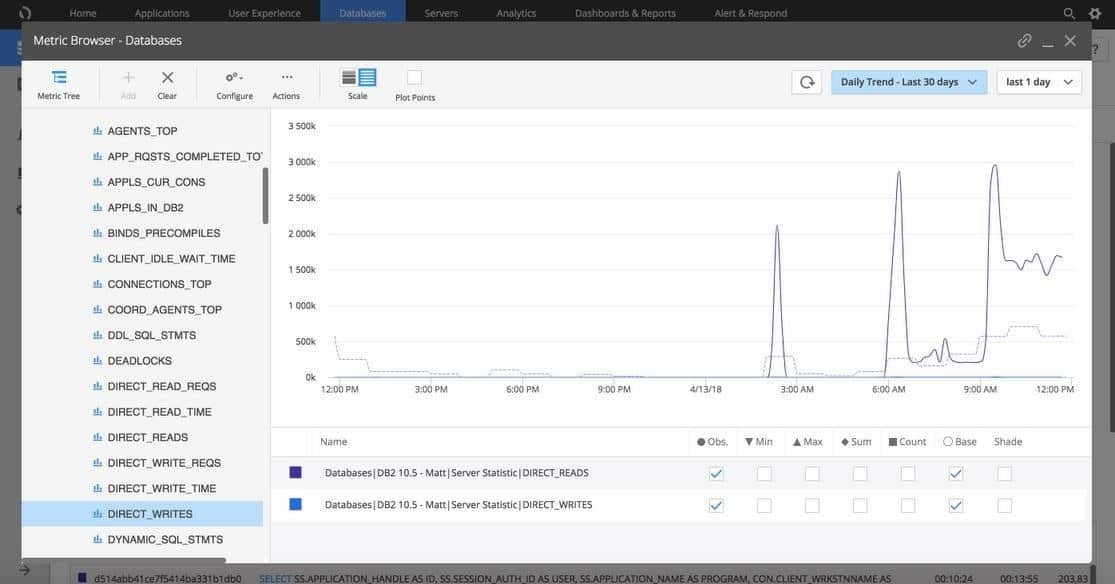IBM’s Db2 is a family of database systems – it isn’t just one service. Among the Db2 range are a relational database management system, Db2 Warehouse, Db2 Hosted, Db2 BigSQL, and Db2 Event Store. Db2 is also available on AWS.
You might use several of those Db2 versions and have instances on different platforms all contributing to multiple services on your system.
Here is our list of the best IBM Db2 monitoring tools:
- ManageEngine Applications Manager EDITOR’S CHOICE A comprehensive package of application performance monitors that includes Db2 monitoring. It is available for Windows Server and Linux. Start a 30-day free trial.
- Site24x7 Infrastructure (FREE TRIAL) A SaaS platform that offers system monitoring bundles and can be extended to perform DB2 health checks. Start a 30-day free trial.
- Datadog Infrastructure A cloud-based monitoring service that tracks the performance of services that back up user-facing software and has a plugin for Db2 monitoring.
- Nagios XI A unified monitor for networks, servers, and applications that includes a Db2 sensor. It installs on Linux or over a hypervisor for Windows Server.
- SolarWinds Database Performance Analyzer This tool creates continuous monitoring for your Db2 instances and also provides optimization assistance.
- Opsview An expandable system monitor that has an extension for Db2 monitoring. This is a cloud-based service.
- AppDynamics Database Monitoring A cloud-based monitoring service from Cisco Systems that includes Db2 performance tracking.
The best IBM Db2 monitoring tools
In our search for the best Db2 monitoring tools, we looked at a range of services from database optimizers to system-wide monitors that can link the monitoring of your Db2 instances with the services that support them and the applications that access them.
We also wanted to provide options for on-premises installation alongside SaaS tools delivered from the cloud. With this range of options, you can narrow down your search further according to whether you particularly need to monitor instances of Db2 running on your own servers or cloud-hosted databases.
Our methodology for selecting IBM Db2 monitoring tools
We reviewed the market for database monitoring systems that cover Db2 and analyzed the options based on the following criteria:
- Systems that can assess database structures for efficiency
- Usage-based database assessments
- The ability to monitor multiple Db2 instances simultaneously
- Correlation with server resource availability
- The ability to monitor other DBMSs as well as Db2
- A free trial or a demo option that provides an opportunity to examine the system before paying
- Value for money from a monitoring package that can simultaneously monitor multiple databases from different DBMSs
1. ManageEngine Applications Manager (FREE TRIAL)
ManageEngine Applications Manager monitors the performance of applications and the servers that support them. This is a very wide-ranging package that has the ability to monitor a long list of applications. Db2 is on that list. The tool can monitor on-premises installations and also cloud-based Db2 instances – notably those available on IBM Cloud and AWS. The service will consolidate the monitoring of many Db2 instances and centralize the monitoring of multiple sites.
Key Features:
- Performance Notifications: Alerts you to issues affecting your applications and databases in real-time.
- Automatic Discovery: Identifies and catalogs applications across your infrastructure for comprehensive monitoring.
- Dependency Insights: Maps out the interconnections between applications, aiding in problem resolution and capacity planning.
- Database Instance Activity Tracking: Monitors availability, connections, cache hit ratio, transaction statistics, and tablespace usage in real time.
- Buffer Pool Optimization: Track buffer pool hit ratios to optimize query performance and minimize disk I/O.
Why do we recommend it?
ManageEngine Applications Manager is a very large package that covers all types of applications, including Web systems. This tool has a database monitoring service and Db2 can be monitored with it. The tool provides you with ongoing database activity statistics and a query analysis function.
The DB2 monitor has its own screens in the dashboard of the Applications Manager. It tracks database information and identifiers, information about the size of objects, tablespaces and entire instances, connection statistics, details on agent performance, transaction statistics, cache, and memory activity, buffer statistics, and tablespace statuses.
The user can nominate a particular database query for special analysis. This service gives extra scrutiny to that query’s efficiency.
The Applications Manager tracks the availability and response times of all Db2 instances. Failure of connection to the database is one cause of alerts and notifications that are raised by the system. Other situations that will cause an alert to arise are resource shortages or performance deterioration.
The dashboard for the Applications Manager shows live performance data in graphs and charts. These screens can be customized and so can the performance thresholds that trip alerts. It is possible to adjust threshold levels or create composite conditions that observe conditions of several metrics.
The Applications Manager includes a system discovery tool, which searches for all active applications. It then examines the interactions between these applications. This includes noting which applications access each Db2 instance. This creates an application dependency map, which provides useful source material for root cause analysis when performance problems arise in the system.
Who is it recommended for?
There is a free version of ManageEngine Applications Manager that will monitor five assets. That’s a nice deal for small businesses. However, the Free edition won’t monitor Db2 databases. It will monitor SQL Server, MySQL, PostgreSQL, Oracle, Memcached, Redis, Cassandra, and MongoDB databases. You need the paid editions for Db2 monitoring.
Pros:
- Flexible Deployment: Available for both on-premises and cloud environments, offering adaptability to various business needs.
- Comprehensive Log Monitoring: Tracks critical metrics such as memory usage, disk IO, and cache status for a holistic view of network health.
- Real-Time Asset Management: Automatically detects and manages databases, server hardware, and other devices, ensuring efficient asset oversight.
- System Load Monitoring: Keep an eye on CPU and memory utilization to identify potential system bottlenecks.
- Deadlock Detection: Identify and resolve deadlocks to prevent application execution issues.
Cons:
- Complex Feature Set: The depth and breadth of features necessitate a significant time investment to leverage the full potential of the platform.
ManageEngine Applications Manager is built for installation on Windows Server or Linux. It is available in three editions: Free, Professional, and Enterprise. The Free version is limited to five monitors. The Professional edition covers a single site and the Enterprise edition will monitor multiple sites. Applications Manager is available for a 30-day free trial.
EDITOR'S CHOICE
ManageEngine Applications Manager is our top pick for an IBM Db2 monitoring tool because it offers a robust suite of features designed to ensure optimal database performance, availability, and reliability. It provides real-time monitoring of key metrics, including CPU usage, memory consumption, query performance, disk I/O, and transaction statistics, which are essential for keeping track of Db2 database health. The tool’s customizable alerting system notifies administrators of potential issues before they affect system performance, enabling proactive troubleshooting. Applications Manager also boasts an intuitive, user-friendly interface, making it easy for both experienced IT professionals and less technical users to monitor and manage Db2 environments. It offers deep visibility into database operations, allowing users to drill down into specific queries and identify bottlenecks or areas for improvement. In addition, the tool supports the automated discovery of Db2 instances, which eliminates the need for manual configuration and saves time. Furthermore, the application provides detailed reports and historical data that help administrators understand long-term trends, aiding in capacity planning and optimization. The scalability of ManageEngine Applications Manager makes it suitable for both small businesses and large enterprises, offering flexibility as your infrastructure grows.
Download: Get a 30-day FREE Trial
Official Site: https://www.manageengine.com/products/applications_manager/download.html
OS: Windows Server, Linux, AWS, and Azure
2. Site24x7 Infrastructure (FREE TRIAL)
Site24x7 is a SaaS platform that provides system monitoring services. The Infrastructure package includes a range of monitoring capabilities including network and server monitoring capabilities. The ability to monitor Db2 databases is contained in a plugin, which can easily be added to the package for free.
Key Features:
- Unified Monitoring: Correlates server and database performance for comprehensive insights.
- Flexible Deployment: Monitors databases whether hosted on-premises or in the cloud.
- Real-Time Data: Provides live statistics and aids in capacity planning for future growth.
Why do we recommend it?
Site24x7 Infrastructure is similar to Datadog in that its core system can be expanded by a library of plug-ins, which are called “integrations. There is an integration for Db2 monitoring. The main benefit of this tool is that it displays live database activity statistics alongside resource allocation and utilization metrics.
The Site24x7 Infrastructure plan includes the capacity to monitor 10 servers. Each server is allowed one free plugin. It is possible to use more than one plugin per server for a fee. In the Site24x7 terminology, a plugin is called an “integration.” However, it isn’t necessary to apply each integration that you need for all servers. So, if you use Db2 on one server, you only need that integration on that server and you can use different plugins on other servers.
The Db2 monitor tracks a list of factors on database activities. The dashboard that shows these live statistics also provides a forecasting service that gives projections of where demand on the database is going and how database size is expected to grow.
An alternative approach to benefit from the extensibility of Site24x7 Infrastructure is to install the Nagios integration. This allows all of the plugins available for Nagios XI to be added in without actually installing Nagios. That means that a single integration allowance can be used as a conduit for thousands of free Nagios plugins that can all operate simultaneously.
Who is it recommended for?
Site24x7 Infrastructure is actually a package of modules rather than z single until You get server, network, and traffic monitoring as well as monitoring for services and software. The plan is sized and priced to be suitable for small businesses and then larger companies pay a supplement for extra capacity.
Pros:
- Comprehensive Solution: A versatile monitoring platform that covers networks, infrastructure, and user experience in one integrated service.
- Intuitive Discovery: Automatically detects devices and generates useful reports and visualizations.
- User-Friendly: Known for its easy-to-navigate interface, making complex monitoring tasks simpler.
- Behavioral Insights: Bridges technical performance with user behavior to inform business decisions.
- Freeware Option: Offers a free version for initial testing and exploration of features.
Cons:
- Learning Curve: The platform’s depth and breadth require an investment of time to master fully.
Site24x7 uses AI to set performance threshold levels. These thresholds trigger alerts when breached and those alerts can be forwarded by email or SMS. While tracking the accesses to each Db2 instance, the Site24x7 service builds up an application dependency map. This is a good foundation for root cause analysis should problems arise. You can experience Site24x7 Infrastructure on a 30-day free trial.
3. Datadog Infrastructure
Datadog is a cloud-based platform that provides system monitoring tools. The Datadog Infrastructure system watches the performance of all of the services that support user-facing applications. The tool can monitor systems wherever they are hosted and is able to unify the monitoring of cloud-based and on-premises resources in one overview.
Key Features:
- Cloud-Based Service: Delivers system monitoring capabilities as a SaaS package.
- Server Performance Tracking: Monitors server activity alongside database performance for a holistic view.
- DBMS Diversity: Supports a wide range of database management systems, including Db2.
- Detailed Insights: Offers both high-level and granular data views for thorough analysis.
Why do we recommend it?
Datadog Infrastructure provides monitoring services for a range of technologies that operate to deliver applications from server resources up to the software that users see. This is except for Web applications, however, services behind Web applications will be monitored. Db2 is just one of the DBMSs that this package will monitor.
The Datadog Infrastructure can be expanded through a library of 400 free plugins, called “integrations.” The library includes an integration for Db2 monitoring. As well as monitoring activity within the database, the tool identifies the applications that access each database instance. It examines locks, buffers, cache, disk interactions, and memory usage. It details each table, column, and index that gets accessed and makes this low-level data available for cross-referencing in the dashboard. These pieces of information build-up to provide rankings of the top accessing applications, the most access tables, and the most required fields in the database.
Information about applications accessing the Db2 instance feeds into an AI process called Correlations, which creates an application dependency map. This service is part of the Enterprise edition of Datadog Infrastructure, which is the highest plan of the service. The Enterprise edition also applies machine learning to create performance thresholds on database objects and resources.
Who is it recommended for?
This cloud-based package is one module on the Datadog platform. The Db2 monitoring capability isn’t immediately available in the Infrastructure monitoring system. It is available in a library of integrations and once you activate that plug-in, the Db2 monitoring page appears in the Datadog console.
Pros:
- Extensive Monitoring: Provides a broad array of real user monitoring tools through templates and widgets.
- Comprehensive View: Offers both internal and external network performance insights for a complete understanding.
- Dynamic Updates: Reflects network changes almost instantly, ensuring data relevance.
- Scalable Solutions: Allows for flexible scaling of monitoring capabilities to suit business needs.
Cons:
- Trial Period: A longer trial would be advantageous for a more in-depth evaluation of its extensive features.
Apart from the Enterprise edition, there are two other plans for Datadog Infrastructure and one of those is free to use. The Free edition is limited to monitoring five hosts. The other edition is called Pro. This includes the ability to monitor Db2 databases, but it doesn’t have the AI features of the Enterprise edition. You can get a 14-day free trial of either of the paid plans.
4. Nagios XI
Nagios XI is a monitoring system for networks, servers, and applications. Its capabilities include the monitoring of Db2 databases. The wider capabilities of Nagios XI mean that you aren’t limited to monitoring just Db2 with this tool. It will also monitor your applications that access your Db2 instances and the servers that support them. It also offers network monitoring, so you get a full stack view with this tool of your entire IT system.
Key Features:
- Self-Hosted Solution: Runs on your own infrastructure, offering full control over the monitoring environment.
- Comprehensive Coverage: Monitors applications, servers, and networks alongside Db2 databases.
- Extensible with Plugins: Enhances monitoring capabilities with a vast selection of community-contributed plugins.
Why do we recommend it?
Nagios XI is a full-stack monitoring system that you run on your own servers. The package includes database monitoring and Db2 is one of the DBMSs that the service can track. This is a performance monitoring tool but it also support some database tuning functions.
The Db2 monitor checks on database availability and response times. It watches issues such as tablespace size, total database size, cache ratios, and database object types and numbers. These basic metric monitors can be expanded by plugins.
The Nagios system has thousands of plugins available. These are provided for free by other users and also by product vendors. There are a number of plugins for Db2 in the community marketplace. These plugins work not only for Nagios XI but also for Nagios Core, which is the free version of Nagios.
Who is it recommended for?
The Nagios XI system is quite expensive, so small businesses probably wouldn’t buy it. However, there is a free version of Nagios, which is called Nagios Core, and that provides the same Db2 monitoring services that Nagios XI offers. This tool will help you plan identify capacity requirements as well as track day-to-day performance.
Pros:
- Streamlined Interface: Offers a straightforward yet informative dashboard for easy data interpretation.
- Versatile Alerts: Provides flexible notification mechanisms, including email and SMS alerts.
- Community Support: Benefits from a rich repository of free plugins for expanded monitoring functionalities.
Cons:
- Limited Support in Free Version: Nagios Core, the open-source counterpart, lacks the comprehensive support available in the paid Nagios XI version.
The main difference between the Nagios Core and Nagios XI systems is that Nagios Core is community supported but Nagios XI comes with a professional support package. Both of these packages run on Linux. If you don’t have a Linux server and want to run the software on Windows, you can install it on top of a Hyper-V or VMWare hypervisor. Nagios XI is available for a 30-day free trial.
5. SolarWinds Database Performance Analyzer
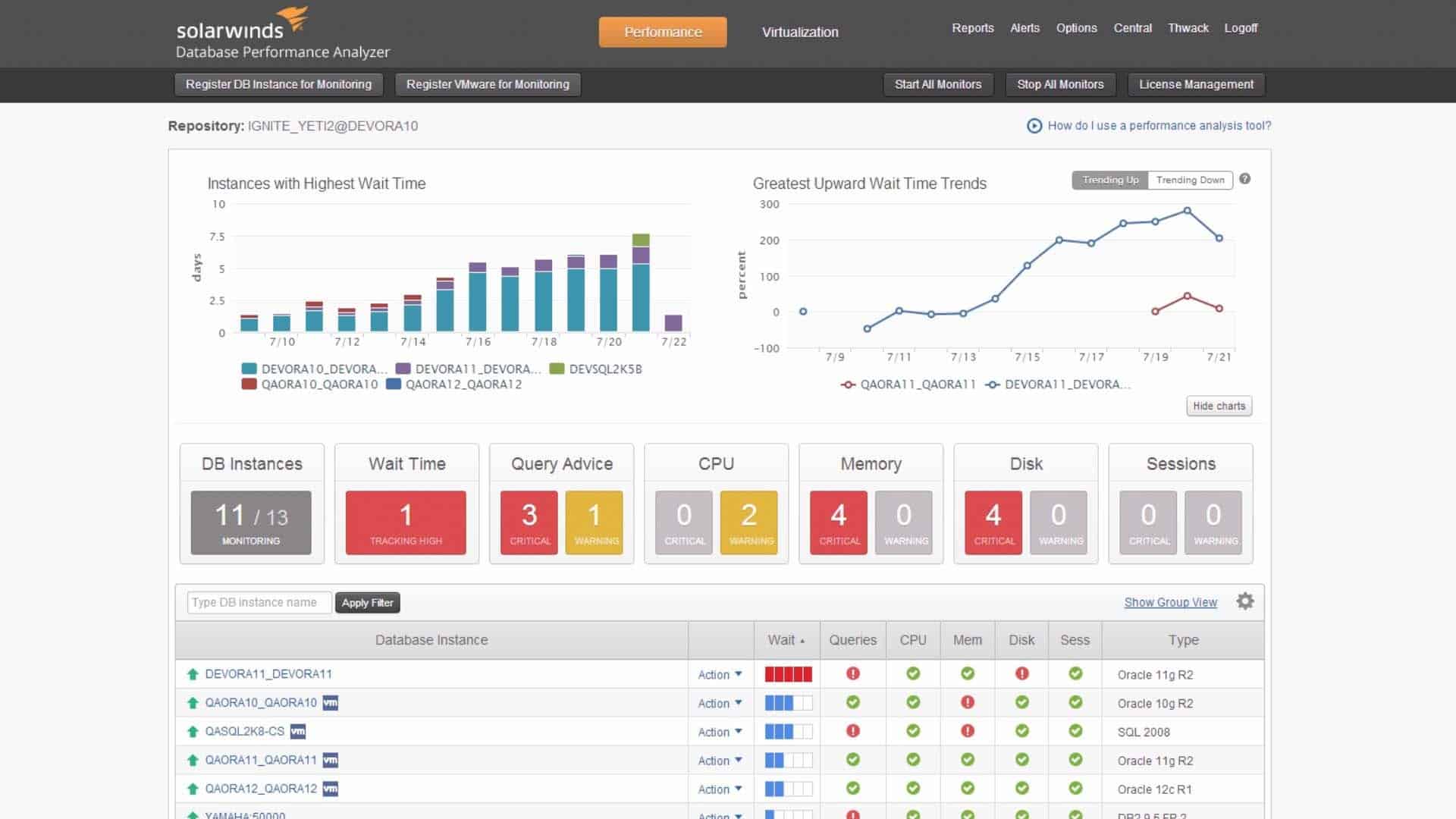
SolarWinds Database Performance Analyzer is a cloud-based service that monitors and tunes Db2 databases. It can access those databases no matter where they are hosted, whether on-premises, on the IBM Cloud servers, or on AWS.
Key Features:
- Cloud Service: Offers flexibility and accessibility for database performance management across various environments.
- Comprehensive Monitoring: Tracks performance across on-premises and cloud-hosted databases simultaneously.
- Performance Insights: Delivers in-depth analysis for optimizing database operations.
- Multidatabase Capability: Supports a wide array of DBMSs, including Db2, for versatile database management.
Why do we recommend it?
SolarWinds Database Performance Analyzer helps you tune your Db2 database and then it implements ongoing monitoring that identifies extra actions that can be taken to improve performance and also looks for unexpected system failures that need to be dealt with. The tool also helps you with capacity planning.
The Database Performance Analyzer starts off as a core package. Subscribers choose from a list of database monitoring modules to set the system up. There is a Db2 integration available. Activating this integration adds on extra monitoring screens in the dashboard for the service. The system then sets itself up to start monitoring your Db2 instances.
This monitoring tool includes guidelines for database design. When it connects to a Db2 database instance for the first time, it assesses the database structure and produces a list of improvements. This is called Best Practices and this module will check all of your Db2 instances in turn, also checking operating system settings. The service will also assess the database replication strategy.
The output from Best Practices will give you work to get started with, adjusting the database. Meanwhile, the Database Performance Analyzer starts monitoring Db2 instance operations. The tool recommends factors to watch and the ideal performance ranges for each.
In the dashboard for the analyzer, you will see live performance data shown as time-series graphs. Those statistics also track operating system performance and resource availability. Live monitoring includes operating system resources as they support the database. The tool calculates the averages for each indicator through a machine-learning process. Deviations from this expected range of performance are then marked as an anomaly and raise an alert.
The Database Performance Analyzer doesn’t just watch database tuning issues. It also monitors the accounts of users accessing the database and logs them. This is a useful service for security tracking.
SolarWinds Database Performance Analyzer is also able to monitor and tune Microsoft Azure SQL, MySQL, PostgreSQL, MariaDB, Oracle, SAP ASE, Redis, and Amazon Aurora databases.
Who is it recommended for?
This system is able to analyze database from many DBMSs, not just Db2. You aren’t limited to monitoring one database with this system and they don’t all have to be of the same DBMS. Your databases can be running on your own servers or on cloud platforms. This is a high-end tool for large businesses.
Pros:
- Sophisticated Management: Ideal for complex database ecosystems, streamlining monitoring and tuning for medium to large organizations.
- Real-Time Alerts: Enhances operational efficiency with instant notifications and integration with common helpdesk systems.
- Proactive Monitoring: Employs threshold alerts to anticipate and address issues before they affect performance.
- Custom Dashboards: Allows for personalized dashboard configurations to suit individual or team preferences.
- Query Optimization: Assists in refining queries for maximum efficiency, bolstered by machine learning for bottleneck identification.
Cons:
- Trial Limitations: A more extended trial period would be beneficial for a thorough evaluation of its comprehensive features.
SolarWinds Database Performance Analyzer is a subscription service and you can experience it on a 14-day free trial.
6. Opsview
Opsview is a monitoring service for networks, servers, and applications. Much of the full capability of Opsview is not immediately available. These services are available in a library of add-ons, which are called “opspacks”. There are opspacks available to monitor Db2. It is also possible to install Nagios plugins in Opsview.
Key Features:
- Db2 Plugin: Offers a specific opspack for monitoring Db2 database instances.
- Application Mapping: Automatically discovers applications and their interdependencies.
- Server Performance Monitoring: Keeps tabs on server health to ensure optimal performance.
Why do we recommend it?
ITRS Opsview is an extensible full-stack monitoring package and it has an extension that adds on Db2 monitoring. This is an opspack and there are many other options in this library of extensions. The Opsview Db2 monitor provides availability checks, which is not as impressive as the other options on this list.
The Db2 monitor in Opsview doesn’t include many metrics for DB2 instances. All it will provide is an availability check. However, this service will reach out to all DB2 instances no matter whether they are local, on remote sites, or on the cloud. Fortunately, the ability to install Nagios plugins in Opsview saves this monitoring system from being completely dismissed by Db2 users.
Opsview is able to monitor a long list of database management systems, not just DB2. This means that you can centralize all of your database monitoring in one console. The Opsview system automatically discovers all operating applications and detects connections between them. So, the Opsview system can compile an application dependency map, which helps with root cause analysis when problems arise in the system.
As with most automated monitoring systems, Opsview employs performance thresholds to enable normal operations to be supervised by the tool without human intervention. The thresholds set ranges of acceptable performance. These settings relate to the availability of supporting resources as well as database issues such as availability and response times. If performance drops or if resources run low, the thresholds trigger alerts. Those alerts can be forwarded as notifications by email, SMS, or Slack message.
Who is it recommended for?
If you want to monitor Db2 instances, Opsview wouldn’t be your first choice. However, if you need to make this monitoring tool work with Db2, there is a workaround. Opsview will accept Nagios plug-ins and those are free to use from the Nagios Exchange library.
Pros:
- Versatile Monitoring: Capable of overseeing a wide range of metrics beyond Db2, from HAProxy to J-Flow.
- User-Friendly Interface: Clean and intuitive dashboard enhances the monitoring experience.
- Customization: Allows for a highly tailored interface to meet specific monitoring needs.
- Version Flexibility: Supports both free and premium versions to accommodate different budgets.
Cons:
- Dependency on Opsview Monitor: Monitoring certain metrics like J-Flow requires the overarching Opsview Monitor system.
Opsview is available for installation on your own host. The software installs on Linux. There are two on-premises versions. One is called SMB. This caters to less than 200 hosts. The larger plan is called Enterprise and this will monitor more than 200 servers. This plan also includes AI processes for services such as threshold setting and root cause analysis. There is also a SaaS version, called Opsview Cloud. This version is available for a free trial.
7. AppDynamics
AppDynamics is a division of Cisco Systems. The company offers a SaaS platform for system monitoring. The services of the platform are offered in a menu of specialized monitoring packages. These are Infrastructure Monitoring, Application Performance Monitoring, Database Monitoring, Business Performance Monitoring, and End User Monitoring. It is possible to subscribe to all of these modules in one package, which is called the Enterprise edition. There is also a bundle called the Premium Edition, which includes Infrastructure, Application, and Database Monitoring.
Key Features:
- Comprehensive DB2 Insights: Evaluates DB2 instances for performance and structure analysis.
- Predictive AI: Utilizes AI for forecasting demand and identifying potential capacity issues.
- Real-Time Monitoring: Tracks live activity statistics for immediate insights into database performance.
Why do we recommend it?
AppDynamics will monitor the entire application stack of your system, running through your DB2 databases. You will see the performance of each database instance, all of the systems that it supports, and all of the resources that it relies on. The service can foresee potential capacity shortages.
One of the database management systems that the Database Monitoring module can supervise is DB2. The system can consolidate the monitoring of database instances running in different locations. It is able to centralize the monitoring of DB2 instances running on Linux, Unix, and Windows.
The DB2 monitor identifies each DB2 instance and assesses its size and structure. It will then watch over transaction activity, memory usage, cache hit rates, access types, and application interactions.
If you also run the Infrastructure Monitoring and Application Performance Monitoring modules, you will benefit from an application dependency map that includes DB2 instances. This service supports root cause analysis.
AppDynamics uses AI processes, which are collectively called Cognition Engine. The Cognition Engine manages performance expectation threshold levels and identifies anomalies. These thresholds raise alerts if performance drops or resources approach exhaustion.
Who is it recommended for?
This is a high-end package and is most suited to mid-sized and large organizations. The tool uses AI to predict resource problems and t will also alert for unexpected errors in your Db2 instances and with any other technology in your infrastructure. This enables you to head off problems quickly.
Pros:
- Enterprise-Oriented: Designed to meet the complex needs of large organizations with a comprehensive monitoring suite.
- Advanced Dependency Mapping: Offers exceptional visual tools for analyzing and troubleshooting interconnected application systems.
- Free Version Available: Provides an opportunity to test some functionalities without initial investment.
Cons:
- Limited Templates: Could benefit from a broader selection of templates for enhanced real-user monitoring capabilities.
AppDynamics is a subscription service with a rate per month for each edition. The service is available for a 15-day free trial.
Db2 monitoring FAQs
What is database monitoring?
The main activity in database monitoring is the collection of live activity data. This should include the conditions of components of the DBMS, such as cache space and sorting and searching activity. Throughput data classifies transactions by insets, deletes, and updates and looks at how the structures of the database respond. Database monitoring does not include recommendations for changes to databases to improve performance or better orders for queries – those are database analysis and query optimization activities.
What is Db2 used for?
Db2 is an IBM product and it is a relational database management system (RDBMS). This means that data can be queried using a structured query language (SQL). Db2 SQL is very similar to the SQL used in SQL Server, MySQL, and Oracle, but not identical. Like other relational databases, Db2 stores data in tables that can be joined together, sorted, and filtered.
What is difference between DB2 and SQL?
Db2 is a relational database management system; SQL is a structured query language. The DB2 system enables the creation of structures to store data, while SQL provides a method to extract data from a relational database.


